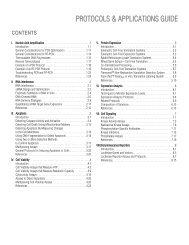Cloning Protocols and Applications Guide-A4 format - Promega
Cloning Protocols and Applications Guide-A4 format - Promega
Cloning Protocols and Applications Guide-A4 format - Promega
You also want an ePaper? Increase the reach of your titles
YUMPU automatically turns print PDFs into web optimized ePapers that Google loves.
||||||||||||| 13<strong>Cloning</strong><br />
MagneGST Glutathione Particles. After elution, the Cav-3<br />
proteins were analyzed using Western blotting.<br />
PubMed Number: 21084288<br />
D. Modifying <strong>and</strong> Restriction Enzymes<br />
<strong>Promega</strong> offers a vast array of both modifying enzymes<br />
(e.g., ligase or phosphatase) <strong>and</strong> restriction endonucleases<br />
for use in cloning. This section is an overview of the<br />
products available from <strong>Promega</strong> to enhance your cloning<br />
results <strong>and</strong> highlights the enzymes that may be most useful<br />
to you. For example, ligase is a key enzyme in cloning as<br />
this enzyme joins the vector <strong>and</strong> insert to create a circular<br />
recombinant plasmid. Restriction enzymes (REs) are used<br />
to cut a vector <strong>and</strong> PCR product, or other type of insert, to<br />
generate compatible ends for ligation. REs also can be used<br />
to evaluate ligation success by screening the recombinant<br />
plasmid for the correct restriction sites. To explore strategies<br />
for subcloning, visit the Subcloning Notebook.<br />
DNA Ligase<br />
DNA ligase catalyzes the joining of two str<strong>and</strong>s of DNA<br />
using the 5´-phosphate <strong>and</strong> the 3´-hydroxyl groups of<br />
adjacent nucleotides in either a sticky-ended or blunt-ended<br />
configuration (Engler <strong>and</strong> Richardson, 1982). This allows<br />
the "pasting" together of inserts <strong>and</strong> receptive vectors (e.g.,<br />
A-tailed product into T vectors).<br />
T4 DNA Ligase (Cat.# M1801, M1804, M1794) can join DNA<br />
str<strong>and</strong>s together <strong>and</strong> has been shown to catalyze the joining<br />
of RNA to a DNA or RNA str<strong>and</strong> in a duplex molecule.<br />
However, DNA ligase will not join single-str<strong>and</strong>ed nucleic<br />
acids (Engler <strong>and</strong> Richardson, 1982).<br />
Additional Resources for T4 DNA Ligase<br />
Technical Bulletins <strong>and</strong> Manuals<br />
9PIM180 T4 DNA Ligase <strong>Promega</strong> Product In<strong>format</strong>ion<br />
The LigaFast Rapid DNA Ligation System (Cat.# M8221,<br />
M8225) is designed for efficient ligation of sticky-ended<br />
DNA inserts into plasmid vectors in just 5 minutes<br />
(blunt-ended inserts in as little as 15 minutes). Rapid<br />
ligation is based on the combination of T4 DNA Ligase with<br />
a unique 2X Rapid Ligation Buffer. The LigaFast System<br />
eliminates any further purification prior to trans<strong>format</strong>ion<br />
of ligated DNA. The specially formulated 2X Rapid Ligation<br />
Buffer requires no additional ATP or Mg2+.<br />
Additional Resources for the LigaFast Rapid DNA<br />
Ligation System<br />
Technical Bulletins <strong>and</strong> Manuals<br />
9PIM822 LigaFast Rapid DNA Ligation System<br />
<strong>Promega</strong> Product In<strong>format</strong>ion<br />
<strong>Protocols</strong> & <strong>Applications</strong> <strong>Guide</strong><br />
www.promega.com<br />
rev. 1/12<br />
<strong>Promega</strong> Publications<br />
<strong>Cloning</strong> differential display-PCR products with pGEM®-T<br />
Easy Vector System<br />
Technically speaking: Subcloning plasmid DNA constructs<br />
Rapid ligation for the pGEM®-T <strong>and</strong> pGEM®-T Easy Vector<br />
Systems<br />
Alkaline Phosphatases<br />
Alkaline phosphatases catalyze dephosphorylation of 5´<br />
phosphates from DNA. These enzymes are used to prevent<br />
recircularization <strong>and</strong> religation of linearized vector DNA<br />
by removing 5´-phosphate groups from both termini <strong>and</strong><br />
also may be used to dephosphorylate 5´ phosphorylated<br />
ends of DNA for subsequent labeling with [32P]ATP <strong>and</strong><br />
T4 Polynucleotide Kinase. Unit usage guidelines are usually<br />
included with the alkaline phosphatase (e.g., 0.01 units per<br />
picomole of ends). For assistance in calculating picomoles<br />
of vector or insert ends for dephosphorylation, visit the<br />
BioMath Calculators.<br />
TSAP Thermosensitive Alkaline Phosphatase (Cat.#<br />
M9910) catalyzes the removal of 5´-phosphate groups from<br />
DNA <strong>and</strong> is effective on 3´ overhangs, 5´ overhangs <strong>and</strong><br />
blunt ends. TSAP is active in all <strong>Promega</strong> restriction enzyme<br />
buffers, a convenience that allows a single, streamlined<br />
restriction enzyme digestion-dephosphorylation step. TSAP<br />
also is inactivated effectively <strong>and</strong> irreversibly by heating<br />
at 74°C for 15 minutes. Therefore, a DNA cleanup step is<br />
not required before ligation.<br />
Additional Resources for TSAP Thermosensitive Alkaline<br />
Phosphatase<br />
Technical Bulletins <strong>and</strong> Manuals<br />
9PIM991 TSAP Thermosensitive Alkaline Phosphatase<br />
<strong>Promega</strong> Product In<strong>format</strong>ion<br />
<strong>Promega</strong> Publications<br />
TSAP Thermosensitive Alkaline Phosphatase activity in<br />
restriction enzyme buffers from New Engl<strong>and</strong> Biolabs<br />
TSAP: A new thermosensitive alkaline phosphatase<br />
Alkaline Phosphatase, Calf Intestinal (CIAP; Cat.# M1821,<br />
M2825), catalyzes the hydrolysis of 5´-phosphate groups<br />
from DNA, RNA <strong>and</strong> ribo- <strong>and</strong> deoxyribonucleoside<br />
triphosphates. This enzyme is not inactivated by heat but<br />
can be denatured <strong>and</strong> removed by phenol extraction. CIAP<br />
is active on 5´ overhangs <strong>and</strong> 5´ recessed <strong>and</strong> blunt ends<br />
(Sambrook et al. 1989; Seeburg et al. 1977; Ullrich et al. 1977;<br />
Meyerowitz et al. 1980; Grosveld et al. 1981).<br />
Additional Resources for Alkaline Phosphatase, Calf<br />
Intestinal<br />
Technical Bulletins <strong>and</strong> Manuals<br />
9PIM182 Alkaline Phosphatase, Calf Intestinal <strong>Promega</strong><br />
Product In<strong>format</strong>ion<br />
<strong>Promega</strong> Publications<br />
Technically speaking: Subcloning plasmid DNA constructs<br />
PROTOCOLS & APPLICATIONS GUIDE 13-8

















